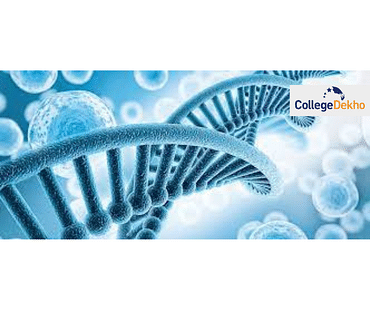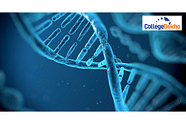GATE life science syllabus 2024 is of utmost importance for candidates preparing for GATE 2024 exam life sciences course. Candidates can check the GATE 2024 life sciences syllabus here in this article.

GATE Life Sciences (XL) Syllabus 2024: Indian Institute of Science (IISc) Bangalore has released the GATE 2024 syllabus of life sciences on its official website. GATe 2024 exam will be conducted by IISc Bangalore on February 3, 4, 10 and 11, 2024 respectively. Candidates preparing for the life science course for GATE exam must have an in-depth knowledge of the life sciences syllabus of GATE 2024. Without prior knowledge and understanding of the GATE life sciences syllabus 2024 it becomes hectic for candidates to prepare well for the exam. However, a detailed analysis of the life science syllabus will enable aspirants to prepare a decisive strategy for the exam. Additionally it benefits the students to know the important topics for the GATE exam as well. Candidates can check the article to know about the entire GATE 2024 life science syllabus along with the important topics here in this article.
Ongoing Event | GATE Application Form 2024 (Released)
GATE 2024 Life Sciences Syllabus - Download PDF
Particulars | Details |
|---|---|
Life Sciences Syllabus of GATE 2024 |
The life sciences section of GATE comprises the following subjects that candidates can take for the exam. The subjects are as follows.
- Biochemistry
- Botany
- Microbiology
- Zoology
- Food Technology
Candidates must take note that chemistry is a compulsory subject for the GATE exam of life sciences course. The detailed syllabus of chemistry along with the important topics has been mentioned in the table below.
Name of the Topics | Syllabus | Important Topics |
|---|---|---|
Atomic Structure and Periodicity | Planck’s Quantum Theory, Wave Particle Duality, Uncertainty Principle, Comparison Between Bohr’s Model And Quantum Mechanical Model Of Hydrogen Atom, Electronic Configuration Of Atoms And Ions. Hund’s Rule And Pauli’s Exclusion Principle. Periodic Table And Periodic Properties: Ionization Energy, Electron Affinity, Electronegativity And Atomic Size. |
|
Structure and Bonding | Ionic And Covalent Bonding, MO And VB Approaches For Diatomic Molecules, Vsepr Theory And Shape Of Molecules, Hybridization, Resonance, Dipole Moment, Structure Parameters Such As Bond Length, Bond Angle And Bond Energy, Hydrogen Bonding And Van Der Waals Interactions. Ionic Solids, Ionic Radii And Lattice Energy (Born‐Haber Cycle). HSAB Principle |
|
s, p and d Block Elements | Oxides, Halides And Hydrides Of Alkali, Alkaline Earth Metals, B, Al, Si, N, P, And S. General Characteristics Of 3d Elements. Coordination Complexes: Valence Bond And Crystal Field Theory, Color, Geometry, Magnetic Properties And Isomerism |
Characteristics of 3D Elements
|
Chemical Equilibria | Osmotic Pressure, Elevation Of Boiling Point And Depression Of Freezing Point, Ionic Equilibria In Solution, Solubility Product, Common Ion Effect, Hydrolysis Of Salts, Ph, Buffer And Their Applications. Equilibrium Constants (Kc, Kp And Kx) For Homogeneous Reactions |
|
Electrochemistry | Conductance, Kohlrausch Law, Cell Potentials, EMF, Nernst Equation, Thermodynamic Aspects And Their Applications |
|
Reaction Kinetics | Rate Constant, Order Of Reaction, Molecularity, Activation Energy, Zero, First And Second Order Kinetics, Catalysis And Elementary Enzyme Reactions. Reversible And Irreversible Inhibition Of Enzymes |
|
Thermodynamics | Qualitative Treatment Of State And Path Functions, First Law, Reversible And Irreversible Processes, Internal Energy, Enthalpy, Kirchhoff Equation, Heat Of Reaction, Hess’s Law, Heat Of Formation. Second Law, Entropy And Free Energy. Gibbs‐helmholtz Equation, Free Energy Change And Spontaneity, Free Energy Changes From Equilibrium Constant |
|
Structure-Reactivity Correlations and Organic Reaction Mechanisms | Acids And Bases, Electronic And Steric Effects, Stereochemistry, Optical And Geometrical Isomerism, Tautomerism, Conformers And Concept Of Aromaticity. Elementary Treatment Of SN1, SN2, E1, E2 And Radical Reactions, Hofmann / Saytzeff Rules, Addition Reactions, Markownikoff Rule And Kharasch Effect. Elementary Hydroboration Reactions. Grignard’s Reagents And Their Uses. Aromatic Electrophilic Substitutions, Orientation Effect As Exemplified By Various Functional Groups. Identification Of Common Functional Groups By Chemical Tests |
|
Chemistry of Biomolecules | Amino Acids, Proteins, Nucleic Acids And Nucleotides. Peptide Sequencing By Chemical And Enzymatic Proteolytic Methods. DNA Sequencing By Chemical And Enzymatic Methods. Carbohydrates (Upto Hexoses Only). Lipids (Triglycerides Only). Principles Of Biomolecule Purification-Ion Exchange And Gel Filtration Chromatography. Identification Of These Biomolecules And Beer-Lambert’s Law |
|
Biochemistry Syllabus of Life Sciences Course
Applicants can check the biochemistry syllabus here in the section below.
Section | Syllabus | Important Topics |
|---|---|---|
Organization Of Life; Importance Of Water; Structure And Function Of Biomolecules: Amino Acids, Carbohydrates, Lipids, Proteins And Nucleic Acids Protein Structure, Folding / Misfolding And Function Myoglobin, Haemoglobin, Lysozyme, Ribonuclease A, Carboxypeptidase And Chymotrypsin |
| |
Enzyme Kinetics, Regulation And Inhibition; Vitamins And Coenzymes Bioenergetics And Metabolism Generation And Utilisation Of ATP Metabolic Pathways And Their Regulation: Glycolysis, Tca Cycle, Pentose Phosphate Pathway, Oxidative Phosphorylation, Gluconeogenesis, Glycogen And Fatty Acid Metabolism Metabolism Of Nitrogen Containing Compounds: Nitrogen Fixation, Amino Acids And Nucleotides. Photosynthesis, Calvin Cycle |
| |
Biochemical Separation Techniques | Ion Exchange, Size Exclusion And Affinity Chromatography, Centrifugation Characterization Of Biomolecules By Electrophoresis DNA Protein And Protein – Protein Interactions UV-Visible And Fluorescence Spectroscopy Mass Spectrometry |
|
Cell Structure And Organelles; Biological Membranes; Action Potential; Transport Across Membranes; Membrane Assembly And Protein Targeting; Signal Transduction; Receptor-Ligand Interaction; Hormones And Neurotransmitters |
| |
Dna Replication, Transcription And Translation DNA Damage And Repair Biochemical Regulation Of Gene Expression Recombinant DNA Technology And Applications: PCR, Site Directed Mutagenesis, DNA-Microarray Next Generation Sequencing Gene Silencing And Editing |
| |
Immune System | Innate And Adaptive Cell Of The Immune System Active And Passive Immunity Complement System Antibody Structure, Function And Diversity B Cell And T Cell Receptors B Cell And T Cell Activation Major Histocompatibility Complex Immunological Techniques: Immunodiffusion, Immune-Electrophoresis, RIA And ELISA, Flow Cytometry Monoclonal Antibodies And Their Applications |
|
Also Read | GATE 2024 Highest Scoring & Important Topics
GATE 2024 Syllabus of Life Sciences - Botany
Candidates can check the botany syllabus here.
Section Name | Syllabus | Important Topics |
|---|---|---|
Plant Systematics | Botanical Nomenclature, History Of Plant Taxonomy, Diversity And Classification Of Plants, APG System Of Plant Classification Phylogenetics And Cladistics, Molecular Taxonomy And DNA Barcoding Centres For Plant Taxonomy And Herbaria In India |
|
Plant Anatomy | Anatomy Of Root, Stem And Leaves, Floral Organs, Embryo And Young Seedlings, Primary And Secondary Meristems, Stellar Organization, Vascular System And Their Ontogeny, Xylem And Phloem Structure, Secondary Growth In Plants And Wood Anatomy, Plant Cell Structure And Differences From Animal Cells |
|
Plant Development; Cell and Tissue Morphogenesis | Life Cycle Of An Angiosperm, Development Of Male And Female Gametophyte Cell Fate Determination And Tissue Patterning Spacing Mechanisms In Trichomes And Stomata Embryogenesis, Organization And Function Of Shoot And Root Apical Meristems Transition To Flowering: Photoperiodism And Vernalization, ABC Model Of Floral Organ Patterning, Pollen Germination, Double Fertilisation, Seed Development; Xylem And Phloem Cell Differentiation, Photomorphogenesis Phytochrome, Cryptochrome, Phototropin Role Of Auxin, Cytokinin, Gibberellins, And Brassinosteroids On Plant Development |
|
Plant Physiology and Biochemistry | Plant water relations, Mechanisms Of Uptake And Transport Of Water, Ions, Solutes From Soil To Plants, Apoplastic And Symplastic Transport Mechanisms Mechanism Of Stomatal Movements, Nitrogen Metabolism, Photosynthesis C3, C4 And Cam Cycles, Photorespiration, Respiration: Glycolysis, TCA Cycle And Electron Transport Chain Plant Responses And Mechanisms Of Abiotic Stresses Including Drought, Salinity, Freezing And Heat Stress, Metal Toxicity Role Of Abscisic Acid In Abiotic Stresses Structure And Function Of Biomolecules (Proteins, Carbohydrates, Lipids, Nucleic Acid), Enzyme Kinetics Structure And Biosynthesis Of Major Plant Secondary Metabolites (Alkaloids, Terpenes, Phenylpropanoids, Flavonoids) Biosynthesis, Mechanism Of Action And Physiological Effects Of Auxin, Cytokinin, Gibberellic Acids, Brassinosteroid, Ethylene, Strigolactone, Abscisic Acid, Salicylic And Jasmonic Acid. Senescence And Programmed Cell Death |
|
Genetics and Genomics | Cell Cycle And Cell Division Principles Of Mendelian Inheritance, Linkage, Recombination, Genetic Mapping Extra Chromosomal Inheritance Introduction To Epigenetics Gene Silencing- Transgene Silencing, Post Transcriptional Gene Silencing, miRNA And siRNA Evolution And Organization Of Eukaryotic Genome Structure, Gene Expression, Gene Mutation And Repair, Chromosomal Aberrations (Numerical: Euploidy And Aneuploidy And Structural: Deletion, Duplication, Inversion, Translocation), Transposons Model Organisms For Functional Genetics And Genomics Introduction To Transcriptomics, Proteomics And Metabolomics |
|
Plant Breeding, Genetic Modification, Genome Editing | Principles, Methods – Selection, Hybridization, Heterosis Male Sterility, Genetic Maps And Molecular Markers, Embryo Rescue, Haploid And Doubled Haploids Plant Tissue Culture: Micropropagation, Embryo Culture And In Vitro Regeneration, Somatic Embryogenesis, Artificial Seed, Cryopreservation, Somaclonal Variation, Somatic Cell Hybridization, Marker-Assisted Selection, Gene Transfer Methods Viz. Direct And Vector-Mediated, Generation Of Transgenic Plants Introduction To Genome Editing: CRISPR/Cas9, Cre-Lox System To Generate Chimaeras Plastid Transformation Chemical Mutagenesis |
|
Economic and Applied Botany | A General Account Of Economically And Medicinally Important Plants- Cereals, Pulses, Plants Yielding Fibres, Timber, Sugar, Beverages, Oils, Rubber, Pigments, Dyes, Gums, Drugs And Narcotics Economic Importance Of Algae, Fungi, Lichen And Bacteria. Major Indian Cash Crops. Effect Of Industrialization On Agricultural Botany Such As Plastic On Fiber Economy. Genetically Modified Crops And Its Regulation Eg. Bt Cotton, Bt Brinjal Golden Rice etc |
|
Plant Pathology | Nature And Classification Of Plant Diseases, Diseases Of Important Crops Caused By Fungi, Bacteria, Nematodes And Viruses, And Their Control Measures (Chemical And Biological) Mechanism (s) Of Pathogenesis, Resistance: Basal, Systemic, Induced Systemic Resistance, Gene For Gene Concept Molecular Detection Of Pathogens; Plant-Microbe Interactions: Symbionts And Mycorrhiza, Pathogens And Pests Signalling Pathways In Plant Defence Response Salicylic Acid (Sa) And Jasmonic Acid (Ja) In Plant-Pathogen And Plant-Herbivore Interaction, Necrosis Host-Parasitic Plant Interaction (Such As Cuscuta) |
|
Ecology and Environment | Ecosystems – Types, Dynamics, Degradation, Biogeochemical Cycles, Ecological Succession Food Webs And Energy Flow Through Ecosystem Vegetation Types Of The World, Indian Vegetation Types And Biogeographical Zones, Climate And Flora Endemism Pollution And Global Climate Change, Speciation And Extinction, Biodiversity And Conservation Strategies, Ecological Hotspots, Afforestation, Habitat Restoration Plant Interactions With Other Organisms Epiphytes, Parasites And Endophytes |
|
Microbiology Syllabus
Candidates can check the microbiology syllabus here in the below table.
Sections | Syllabus | Important Topics |
|---|---|---|
Historical Perspective | Discovery Of Microbial World; Landmark Discoveries Relevant To The Field Of Microbiology; Controversy Over Spontaneous Generation; Role Of Microorganisms In Transformation Of Organic Matter And In The Causation Of Diseases |
|
Methods in Microbiology | Pure Culture Techniques Principles Of Microbial Nutrition Enrichment Culture Techniques For Isolation Of Microorganisms Antigen And Antibody Detection Methods For Microbial Diagnosis Light-Phase Contrast, Fluorescence And Electron-Microscopy PCR, Real-Time PCR For Quantitation Of Microbes Next Generation Sequencing Technologies In Microbiology |
|
Microbial Taxonomy and Diversity | Bacteria, Archaea And Their Broad Classification; Eukaryotic Microbes: Yeasts, Moulds And Protozoa; Viruses And Their Classification; Molecular Approaches To Microbial Taxonomy And Phylogeny |
|
Prokaryotic Cells: Structure and Function | Prokaryotic Cells: Cell Walls, Cell Membranes And Their Biosynthesis, Mechanisms Of Solute Transport Across Membranes, Flagella And Pili, Capsules, Cell Inclusions Like Endospores And Gas Vesicles Bacterial Locomotion, Including Positive And Negative Chemotaxis | Bacterial Locomotion, Including Positive And Negative Chemotaxis |
Microbial Growth | Definition Of Growth; Growth Curve Mathematical Expression Of Exponential Growth Phase Measurement Of Growth And Growth Yields Synchronous Growth Continuous Culture Effect Of Environmental Factors On Growth Bacterial Biofilm And Biofouling |
|
Control of Microorganisms | Disinfection And Sterilisation: Principles, Methods And Assessment Of Efficacy | |
Microbial Metabolism | Energetics: Redox Reactions And Electron Carriers Electron Transport And Oxidative Phosphorylation An Overview Of Metabolism Glycolysis Pentose-Phosphate Pathway Entner-Doudoroff Pathway Glyoxylate Pathway The Citric Acid Cycle Fermentation Aerobic And Anaerobic Respiration Chemolithotrophy Photosynthesis Calvin Cycle Biosynthetic Pathway For Fatty Acids Synthesis Common Regulatory Mechanisms In Synthesis Of Amino Acids Regulation Of Major Metabolic Pathways |
|
Microbial Diseases and Host Pathogen Interaction | Normal Microbiota Classification Of Infectious Diseases Reservoirs Of Infection Nosocomial Infection Opportunistic Infections Emerging Infectious Diseases Mechanism Of Microbial Pathogenicity Nonspecific Defence Of Host Antigens And Antibodies Humoral And Cell Mediated Immunity Vaccines Passive Immunisation Immune Deficiency Human Diseases Caused By Viruses, Bacteria, And Pathogenic Fungi |
|
Chemotherapy / Antibiotics | General Characteristics Of Antimicrobial Drugs Antibiotics: Classification Molecular Mechanism Of Mode Of Action And Resistance Antifungal And Antiviral Drugs | Antifungal And Antiviral Drugs |
Microbial Genetics | Types Of Mutation UV And Chemical Mutagens Selection Of Mutants Ames Test For Mutagenesis Bacterial Genetic System: Transformation, Conjugation, Transduction, Recombination, Plasmids, Transposons DNA Repair Regulation Of Gene Expression: Repression And Induction Operon Model Bacterial Genome With Special Reference To E.Coli Phage Λ And Its Life Cycle RNA Mutation In Virus Genomes, Virus Recombination And Reassortment Basic Concept Of Microbial Genomics |
|
Microbial Ecology | Microbial Interactions Carbon, Sulphur And Nitrogen Cycles Soil Microorganisms Associated With Vascular Plants Bioremediation Uncultivable Microorganisms Basic Concept Of Metagenomics And Metatranscriptomics |
|
GATE 2024 Life Sciences Syllabus of Zoology
Aspiring candidates can check the zoology syllabus and important topics given in the table below.
Sections | Syllabus | Important Topics |
|---|---|---|
Animal Diversity | Distribution, Systematics And Classification Of Animals, Phylogenetic Relationships (Based On Classical And Molecular Phylogenetic Tools) | |
Evolution | Origin And History Of Life On Earth, Theories Of Evolution, Natural Selection, Adaptation, Speciation |
|
Genetics | Basic Principles Of Inheritance, Molecular Basis Of Heredity, Sex Determination And Sex-Linked Characteristics, Cytoplasmic Inheritance, Linkage, Recombination And Mapping Of Genes In Eukaryotes, Population Genetics, Genetic Disorders, Roles Of Model Organisms In Understanding Genetic Principles |
|
Biochemistry and Molecular Biology | Nucleic Acids, Proteins, Lipids And Carbohydrates Replication, Transcription And Translation, Krebs Cycle, Glycolysis, Enzyme Catalysis, Hormones And Their Actions, Roles Of Vitamins And Minerals |
|
Cell Biology | Basic Principles Of Cellular Microscopy, Structure Of Cell, Cytoskeletal Organisation, Cellular Organelles And Their Structure And Function, Cell Cycle, Cell Division, Chromosomes And Chromatin Structure |
|
Gene Expression in Eukaryotes | Eukaryotic Genome Organisation And Regulation Of Gene Expression, Transposable Elements | |
Animal Anatomy and Physiology | Comparative Physiology, The Respiratory System, Muscular System, Circulatory System, Digestive System, The Nervous System, The Excretory System, The Endocrine System, The Reproductive System, The Skeletal System | |
Parasitology and Immunology | Nature Of Parasite, Host-Parasite Relation, Protozoan and Helminthic Parasites, The Immune Response, Cellular And Humoral Immune Response |
|
Development Biology | Gametogenesis, Embryonic Development, Cellular Differentiation, Organogenesis, Metamorphosis, Model Organisms Used In Developmental Biology, Genetic And Molecular Basis Of Development, Stem Cells |
|
Ecology | The Ecosystem, Animal Distribution, Ecological Niche And Its Contribution To Ecological Diversity, The Food Chain, Population Dynamics, Species Diversity, Zoogeography, Biogeochemical Cycles, Conservation Biology, Ecotoxicology |
|
Animal Behaviour | Type of Behaviours, Courtship, Mating and Territoriality, Instinct, Learning and Memory, Social Behaviour Across The Animal Taxa, Communication, Pheromones, Evolution of Behaviour In Animals |
|
Food Technology Syllabus
Aspirants can check the food technology syllabus here.
Section | Syllabus | Important Topics |
|---|---|---|
Food Chemistry and Nutrition | Carbohydrates: Structure And Functional Properties Of Mono-, Oligo-, & Poly- Saccharides Including Starch, Cellulose, Pectic Substances And Dietary Fibre, Gelatinization And Retrogradation Of Starch Proteins: Classification And Structure Of Proteins In Food, Biochemical Changes In Post Mortem And Tenderization Of Muscles Lipids: Classification And Structure Of Lipids, Rancidity, Polymerization And Polymorphism Pigments: Carotenoids, Chlorophylls, Anthocyanins, Tannins And Myoglobin Food Flavours: Terpenes, Esters, Aldehydes, Ketones And Quinones Enzymes: Specificity, Simple And Inhibition Kinetics, Coenzymes, Enzymatic And Non- Enzymatic Browning Nutrition: Balanced Diet, Essential Amino Acids And Essential Fatty Acids, Protein Efficiency Ratio, Water Soluble And Fat Soluble Vitamins, Role Of Minerals In Nutrition, Co-Factors, Anti-Nutrients, Nutraceuticals, Nutrient Deficiency Diseases Chemical And Biochemical Changes: Changes Occur In Foods During Different Processing |
|
Food Microbiology | Characteristics Of Microorganisms: Morphology Of Bacteria, Yeast, Mould And Actinomycetes, Spores And Vegetative Cells, Gram-Staining Microbial Growth: Growth And Death Kinetics, Serial Dilution Technique Food Spoilage: Spoilage Microorganisms In Different Food Products Including Milk, Fish, Meat, Egg, Cereals And Their Products Toxins From Microbes: Pathogens And Non-Pathogens Including Staphylococcus, Salmonella, Shebelle, Escherichia, Bacillus, Clostridium, And Aspergillums Genera Fermented Foods And Beverages: Curd, Yoghurt, Cheese, Pickles, Soya Sauce, Sauerkraut, Idly, Dose, Vinegar, Alcoholic Beverages And Sausage |
|
Food Products Technology | Processing Principles: Thermal Processing, Chilling, Freezing, Dehydration, Addition Of Preservatives And Food Additives, Irradiation, Fermentation, Hurdle Technology, Intermediate Moisture Foods Food Packaging And Storage: Packaging Materials, Aseptic Packaging, Controlled And Modified Atmosphere Storage Cereal Processing And Products: Milling Of Rice, Wheat, And Maize, Parboiling Of Paddy, Bread, Biscuits, Extruded Products And Ready To Eat Breakfast Cereals Oil Processing: Expelling, Solvent Extraction, Refining And Hydrogenation Fruits And Vegetables Processing: Extraction, Clarification, Concentration And Packaging Of Fruit Juice, Jam, Jelly, Marmalade, Squash, Candies, Tomato Sauce, Ketchup, And Puree, Potato Chips, Pickles Plantation Crops Processing And Products: Tea, Coffee, Cocoa, Spice, Extraction Of Essential Oils And Oleoresins From Spices Milk And Milk Products Processing: Pasteurisation And Sterilisation, Cream, Butter, Ghee, Ice- Cream, Cheese And Milk Powder Processing Of Animal Products: Drying, Canning, And Freezing Of Fish And Meat; Production Of Egg Powder Waste Utilisation: Pectin From Fruit Wastes, Uses Of By-Products From Rice Milling Food Standards and Quality Maintenance: FPO, PFA, A-Mark, ISI, HACCP, Food Plant Sanitation and Cleaning in Place (CIP) |
|
Food Engineering | Mass And Energy Balance: Momentum Transfer: Flow Rate And Pressure Drop Relationships For Newtonian Fluids Flowing Through Pipe, Reynolds Number Heat Transfer: Heat Transfer By Conduction, Convection, Radiation, Heat Exchangers Mass Transfer: Molecular Diffusion And Flick's Law, Conduction And Convective Mass Transfer, Permeability Through Single And Multilayer Films Mechanical Operations: Size Reduction Of Solids, High Pressure Homogenization, Filtration, Centrifugation, Settling, Sieving, Mixing & Agitation Of Liquid Thermal Operations: Thermal Sterilisation, Evaporation Of Liquid Foods, Hot Air Drying Of Solids, Spray And Freeze-Drying, Freezing And Crystallisation Mass Transfer Operations: Psychometric, Humidification And Dehumidification Operations |
Sterilisation, Evaporation Of Liquid Foods, Hot Air Drying Of Solids
|
Also Read |
Important Books to Cover GATE Life Sciences Syllabus 2024
Students preparing for the GATE 2024 life sciences course must check the list of important books to cover the GATE 2024 syllabus of life sciences.
Subject | Section | Name of the Book | Author |
|---|---|---|---|
Chemistry | Physical Chemistry | Physical Chemistry | Ira N. Levine |
Organic Chemistry | Organic Chemistry | Jonathan Clayden, Nick Greeves, Stuart Warren | |
Inorganic Chemistry | Principles of Inorganic Chemistry | Late B.R.Puri, L.R. Sharma, K.C.Kalia | |
Biochemistry | Biochemistry | Lehninger Principles of Biochemistry | Nelson and Cox |
Principles of Biochemistry | Voet, Pratt and Voet | ||
Enzymes | Enzymes: Biochemistry, Biotechnology, Clinical Chemistry, 2/E | Trevor Palmer and Philip Bonner | |
Cellular Organization | Molecular Biology of the Cells | Bruce Alberts | |
The Cell: A Molecular Approach | Geoffrey M. Cooper, and Robert E. Hausman | ||
Immunology | Immunology | Kuby | |
Essential Immunology | Ivan M. Roitt | ||
Genetics | Principles of Gene Manipulation and Genomics | S.B. Primrose and R.M. Twyman | |
Principles of Genetics | Snustad | ||
Botany | Botany | Plant Physiology | Taiz and Zeiger |
Introductory Plant Biology | Stern | ||
Ecology and Environment | Basic Ecology: Fundamentals of Ecology | Eugene P. Odum | |
Microbiology | Microbiology | Prescott | |
Microbiology | Pelczar | ||
Zoology | Zoology | Animal Biology | Jurd |
Vertebrates Comparative Anatomy - Function and Evolution | Kardong | ||
Development Biology | Development Biology | Scott F. Gilbert | |
Food Technology | Nutrition | Advanced textbook on Food and Nutrition Vol. 1 | Dr M. Swaminathan |
Food Engineering | Processing and Food Engineering | M K Garg and Pritam Chandra | |
Fundamentals of Food Engineering | D G Rao | ||
Food Chemistry | Food Chemistry | Meyer, Fenema | |
Food Products Technology | Outline of Dairy Technology | Sukumar Dey | |
Post Harvest Technology of Cereals and Pulses | Chakravarty |
GATE preparation is not a simple endeavour, especially in light of the exam's high level of competition and its syllabus. However, passing GATE 2024 maximises one's prospects to create a secure future and take the lead in the global community. By outlining each component of the GATE 2024 life science syllabus and highlighting the crucial topics that might receive the most weightage, we have attempted to reduce the amount of work that candidates have to do.
Are you feeling lost and unsure about what career path to take after completing 12th standard?
Say goodbye to confusion and hello to a bright future!

GATE Previous Year Question Paper
Was this article helpful?



















Similar Articles
BITSAT Slot Booking 2025 - Dates (Phase 1 May 13-16), Direct Link, Process, How to Book
IIT Placements 2024-25: Highest Package Offered, Top Recruiters
OJEE B.Arch Counselling 2025: Dates, Seat Allotment, Application Form, Eligibility, Process, Documents
List of Documents Required for JoSAA Counselling 2025 - Upload Process, Instructions
List of Colleges for 50,000 to 75,000 Rank in AP EAPCET (EAMCET)
JEE Advanced Marks vs Rank OBC